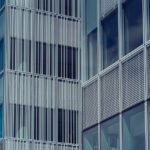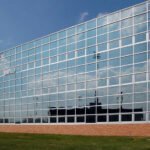Glass has been a central element in architecture and design for centuries, valued for its transparency and versatility. However, in modern interiors and facades, there is often a need to balance light transmission with privacy and aesthetics. This is where acid-etched glass comes in.
Acid-etched glass in Dubai is widely used in offices, hotels, retail spaces, and homes. From luxury malls like the Dubai Mall to office towers in New York City, acid-etched glass is a preferred material for partitions, shower doors, and decorative elements.
According to Statista (2023), the global architectural glass market is expected to reach USD 153 billion by 2030, driven in part by demand for specialty glass like etched and laminated varieties (Statista, 2023).
What is Acid-Etched Glass?
Acid-etched glass is a type of glass that undergoes a chemical process where the surface is treated with hydrofluoric acid. This permanently alters the smooth surface, giving it a frosted, satin-like appearance.
How It’s Made (Step-by-Step):
- A sheet of float glass (clear or tinted) is selected.
- Hydrofluoric acid is carefully applied to the surface.
- The acid reacts with the silica in the glass, dissolving the glossy surface.
- The result: a matte, non-reflective, smooth finish.
Clear vs. Acid-Etched Glass
| Feature | Clear Glass | Acid-Etched Glass |
| Transparency | 100% | Semi-transparent |
| Glare | High | Reduced |
| Fingerprint Resistance | Low | High |
| Applications | Windows | Partitions, doors, decor |
Benefits of Acid-Etched Glass
- Aesthetic Appeal
- Smooth matte finish adds elegance.
- Works well in both traditional and contemporary designs.
- Smooth matte finish adds elegance.
- Privacy Without Blocking Light
- Allows diffused natural light while ensuring privacy.
- Ideal for bathroom doors, office partitions, and hospital wards.
- Allows diffused natural light while ensuring privacy.
- Low Maintenance
- Resistant to fingerprints and smudges.
- Cleaning requires only mild soap and water.
- Resistant to fingerprints and smudges.
- Durability
- The etched surface is permanent and does not peel or wear off.
- Can be tempered or laminated for added strength.
- The etched surface is permanent and does not peel or wear off.
- Safety
- When laminated, acid-etched glass becomes shatter-resistant, making it safer for public spaces.
- When laminated, acid-etched glass becomes shatter-resistant, making it safer for public spaces.
Real Example:
- Bangalore’s IT parks (e.g., Embassy Tech Village) use acid-etched glass in conference room partitions for a sleek, modern aesthetic while maintaining privacy.
- Hospitality industry in Las Vegas often prefers etched glass for bathroom enclosures due to its easy maintenance and uniform finish.
What Is the Difference Between Acid-Etching & Sandblasting?
Although both techniques produce a frosted effect, acid-etching and sandblasting are different processes:
- Acid-Etching: Chemical process that delivers a smooth, satin-like finish.
- Sandblasting: Mechanical process that uses high-pressure sand or grit to create a grainy, rough finish.
Read also: Top 10 Shower Enclosure Designs to Upgrade Your Bathroom in 2025
Acid-Etching vs. Sandblasting
| Aspect | Acid-Etching | Sandblasting |
| Process | Chemical (acid) | Mechanical (abrasion) |
| Finish | Smooth, satin-like | Grainy, rough texture |
| Durability | Permanent | Can wear over time |
| Cost | Moderate | Higher (labor-intensive) |
| Best For | Large-scale uniform use | Custom patterns, signage |
Examples:
- Hotels in Dubai and Las Vegas choose acid-etched glass for bathrooms and lobbies due to its uniformity and durability.
- Art studios in California use sandblasting to create customized patterns, signage, and logos on glass.
Acid-Etched Glass Applications
Acid-etched glass has a broad range of applications across industries:
Residential
Shower enclosures, bathroom doors, kitchen cabinet panels.
Commercial
Office partitions, sliding doors, meeting room dividers.
Hospitality
Hotels and spas use etched glass for decorative walls and privacy screens.
Retail
Storefronts, display cases, and fitting rooms.
Architecture
Used in facades, skylights, and curtain walls for a softer, glare-free finish.
Global Applications of Acid-Etched Glass (% Share)
- Residential – 25%
- Commercial – 30%
- Hospitality – 20%
- Retail – 15%
- Architecture/Other – 10%
The Many Possibilities of Acid-Etched Glass
The versatility of acid-etched glass makes it ideal for both functional and artistic uses:
- Custom Designs
- Company logos, artistic patterns, or decorative motifs can be added.
- Color Coatings
- Acid-etched glass can be combined with tinted or back-painted glass to create luxury interiors.
- Back-Painting
- Popular in kitchen backsplashes and feature walls.
- Combination with Laminated Glass
- Provides both safety and aesthetics, especially in public buildings.
Examples:
- Burj Khalifa interiors (Dubai) incorporate etched panels for an elegant look.
Apple Stores use etched glass to maintain their minimalist, high-end brand aesthetic.
Conclusion
Acid-etched glass strikes the perfect balance between style, privacy, and functionality. With its smooth, satin-like surface, it has become a favorite in architecture, retail, and hospitality projects worldwide. From corporate office spaces in Bangalore to luxury hotels in Dubai and Las Vegas, acid-etched glass is shaping modern interior design.
As demand for sustainable and aesthetically pleasing building materials grows, acid-etched glass will continue to be an essential component of 21st-century design and construction.





